
It is more than just the air we breathe. It is the shield that protects and encompasses our planet. Should we battle the sun with a damaged shield?
In the first installment of this series, we took a look at cycles of planetary motion that have influenced the climate of Earth for billions of years. Be sure to read the first part for a more comprehensive explanation!
Milankovitch Summary
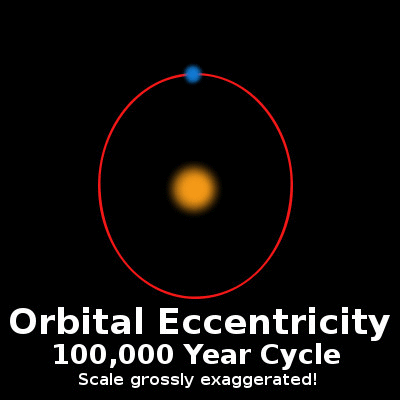
Earth's Atmosphere
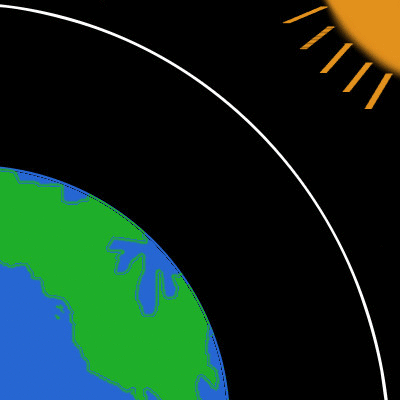 'Normal' atmospheric conditions where the ozone layer (white) filters out harmful UV radiation while some sunlight (orange) is absorbed by the planet and the rest is reflected back to space. Scales grossly exaggerated!
'Normal' atmospheric conditions where the ozone layer (white) filters out harmful UV radiation while some sunlight (orange) is absorbed by the planet and the rest is reflected back to space. Scales grossly exaggerated!Trapped Heat
Imagine parking a car in the sun on a hot summer day with the windows rolled up. The air in the car rapidly warms up to deadly temperatures that far exceed that of the outside air. The windows of the car allow sunlight and heat to pass into the car, but most of that energy is unable to escape. In a similar way, greenhouse gases in the atmosphere can trap heat and enhance the amount of solar radiation that the planet absorbs.Greenhouse Gases
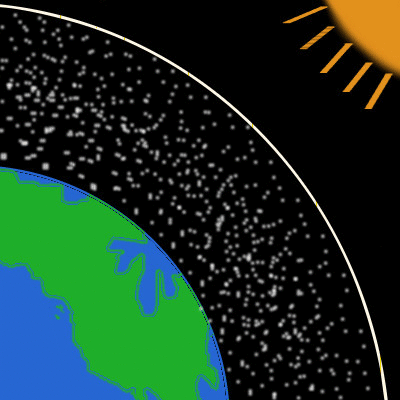 An atmosphere with increased greenhouse gas (grey dots) absorbs more incoming solar radiation and causes the planet to warm more rapidly. Scales grossly exaggerated!
An atmosphere with increased greenhouse gas (grey dots) absorbs more incoming solar radiation and causes the planet to warm more rapidly. Scales grossly exaggerated!Water Vapor
Water vapor is a greenhouse gas that may account for as much as 60% of the greenhouse gas warming effect observed today. The amount of water vapor that can be suspended by air is directly proportional to the air temperature. As the global temperatures increase, the capacity of water vapor that can be suspended by the air also increases. This factor makes the concentrations of other greenhouse gases even more influential, as any net increase in greenhouse gas is multiplied by the increased water vapor carrying capacity.Natural Sources
The concentration of CO2 and other greenhouse gases are influenced by several natural processes. One of the largest sources is volcanic eruptions, which is generally a mixture of carbon dioxide, methane, water vapor, and various other gases. Active tectonic plate boundaries and volcanoes worldwide are constantly emitting massive amounts of gas and dust into the atmosphere. Additionally, the process of lava and magma cooling into rock can release gases. Animals, swamps, peat bogs, and decaying organisms are natural sources of methane and carbon dioxide. Greenhouse gas sources are even found throughout the oceans.Anthropogenic Sources
It is time to address the elephant in this global room. Human activity has altered our planet and increased the concentrations of greenhouse gases. In countries like the United States, the extraction, processing, and burning of fossil fuels such as oil, natural gas, and coal has increased (often exponentially) since the industrial revolution. This has unquestionably led to an increase in the amount of CO2 in the atmosphere since the gas is released as a byproduct of fossil fuel combustion. This growing demand for electricity, the heating and cooling of buildings, and rapid transportation does not appear to be slowing any time soon.Other human activities such as livestock grazing, deforestation, chemical and aerosol production, industry, agriculture, and mining also contribute to the increasing concentrations of greenhouse gases like methane, CO2, and chlorofluorocarbon (CFCs). Fortunately, some progress has been made in recent years toward reducing the production of CFCs in the United States and other countries after it was shown that they can lead to ozone layer depletion.

Natural Carbon Sinks
Nearly three-quarters of the surface of our planet is covered by water. The ocean is the single largest CO2 sink that there is. In addition to carbon being dissolved directly by the water, there are photosynthetic organisms (algae, cyanobacteria) that respire carbon and other life that use carbon to form rigid carbonate shells. On land, any type of photosynthetic organism has the ability to fix carbon and turn CO2 into O2. This includes trees, grasses, crops, algae, shrubs, and other plants.Effects of Warming
Short-Term
Over a time scale of decades to centuries, the effects of a continued warming trend are two-fold. An increase in temperature and atmospheric water vapor will lead to increased crop yield in many places, though cycles of drought and extreme weather conditions like hurricanes will also become more common. The melting of ice in Antarctica and Greenland will cause a rise in sea level and a loss of some coastal land, but the warming trend will cause inhospitable land in the polar regions to become more temperate.Long-Term
When greater time scales are considered, the consequences of increasing greenhouse gas concentrations may be counter-intuitive. As more CO2 is dissolved by the warming oceans, the ocean waters become more acidic and less hospitable for most forms of life. In fact, the diversity of life will decrease as species struggle to adapt to the changing climate and go extinct. On time scales this great, the Milankovitch cycles discussed in part 1 start to have their own influence on global climate and muddle the blame. Ultimately, it seems that the long-term consequence of warming might be extreme cooling...Negative Feedbacks
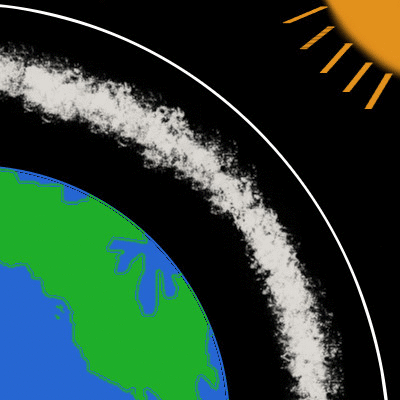 Increased cloud cover reflects much of the incoming solar radiation and causes the planet to cool faster. Scales grossly exaggerated!
Increased cloud cover reflects much of the incoming solar radiation and causes the planet to cool faster. Scales grossly exaggerated!The vast clouds of ash and dust propelled into the atmosphere during volcanic eruptions and other celestial events (such as meteor impacts) can help to counteract the increase in greenhouse gases by reflecting solar radiation before it reaches earth. This can cause prolonged periods of cooling that encourage the onset of ice ages.
Similarly, as global temperatures increase and as water vapor accumulates in the atmosphere, the vapor forms into clouds. An increase in cloud cover will reflect most sunlight away from the earth before it has a chance to reach the surface and contribute heat. This will lead to a cooling of the planet and in turn reduce the amount of water vapor that can remain suspended in the air.
Ocean Currents and Ice Caps
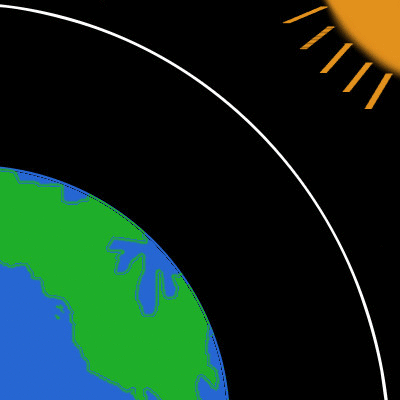 A disruption of the flow of ocean currents and seasonal extremes can cause the formation of ice caps. The increased albedo of snow on the Earth's surface reflects solar energy. Scales grossly exaggerated!
A disruption of the flow of ocean currents and seasonal extremes can cause the formation of ice caps. The increased albedo of snow on the Earth's surface reflects solar energy. Scales grossly exaggerated!